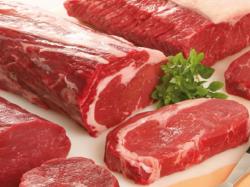Get Cooking In May During Kansas Beef Month
May 28, 2010 | 3 min to read

TOPEKA, Kan. — As a recognized center of high-quality beef with approximately 6 million cattle on ranches and feedyards, Kansas recognizes May as the 26th Annual Kansas Beef Month. More than 30,000 beef producers from across the state invite families to celebrate Kansas Beef Month by enjoying a mouthwatering steak from the grill.
There are as many ways to prepare beef as there are reasons to love beef, according to the Kansas Beef Council. “Grilling beef is a great way to provide not only a delicious summertime meal, but a healthy one as well. Consuming a 3-ounce portion of lean beef provides 51 percent of your daily protein needs, and those cuts are great on the grill,” says Heidi Wells, R.D., C.S.S.D., L.D., director of nutrition for the Kansas Beef Council.
To celebrate Kansas Beef Month, the council is providing some sizzling advice from Chef Dave Zino, with the National Cattlemen’s Beef Association. “It just might be the inspiration you need to kick off your summer grilling season this month,” says Wells.
The key to that savory, unforgettable beef meal is to match your steak or roast to the proper cooking method to ensure tender results, according to Zino. Be sure to check and follow purchasing and cooking instructions because the correct match is essential for maximum eating enjoyment.
“The filet mignon, T-bone and sirloin taste best when cooked using dry heat, which is characterized by quick cooking at higher temperatures. That’s why these cuts work so well when grilled,” Zino said. “Broiling or cooking in a skillet also are ways to cook with dry heat. For less tender cuts, such as the chuck roast or bottom round roast, moist heat cooking techniques, such as braising and stewing, are best,” Zino explained.
Zino had additional tips for lovingly creating the beef dishes you love:
- Hit the Right Temperature: Insert an instant-read thermometer horizontally into the side of a steak to check doneness. Aim for a reading between 145°F (medium rare) to 160°F (medium), which are the ideal temperatures for tender, juicy steaks.
- Bring out the Best: Pair a marinade or rub with the appropriate cut to bring out the best in beef. For naturally tender steaks, apply a simple rub made with fresh herbs, garlic and spices for at least 15 minutes, but no more than two hours.
For less-tender steaks such, as the top round, flank or skirt, a marinade incorporating an acidic ingredient, such as vinegar, wine or citrus juice, will tenderize and add flavor. For best results, marinate these cuts at least six hours, but no more than 24 hours.
- Create Chemistry: Beef develops its desirable flavor and aroma during the cooking process, especially when browned. Browning causes beef’s proteins and carbohydrates to caramelize, resulting in a burst of intense flavor that’s sure to seduce beef lovers. Use a medium-heat setting and be sure not to crowd the pan for optimum browning and flavor development.
- Unleash the Power: Umami, which comes from the Japanese word for “delicious,” is the fifth taste described as meaty or savory. To amp up the flavor intensity of already delicious beef, marry it with other natural sources of umami, such as mushrooms, tomatoes or aged cheese, for a synergistic flavor explosion.
- Practice Safe Serving: Keep raw meat separate from other foods, both in the refrigerator and during preparation. Wash hands, all utensils and surfaces in hot, soapy water after contact with raw meat. Never place cooked meat on platters that held raw meat. Use clean serving platters and utensils. Serve cooked food promptly and refrigerate immediately after serving (within two hours after cooking).
- Extend the Love: Instead of buying pre-cut beef for kabobs, stew and stir-fry, save money by buying steaks or roasts and cutting them into cubes or strips. Plan ahead and freeze your beef for six to 12 months.
For more ideas on creating the ultimate beef experience, visit www.BeefItsWhatsForDinner.com and click on the “Cooking with Beef” tab for a chart that matches cooking methods with various cuts of beef.
About the Kansas Beef Council
Based in Topeka, The Kansas Beef Council was first formed in 1973 by the Kansas Livestock Association for the purpose of beef promotion in the state of Kansas and is directed by a board of volunteer cattle producers from across the state and funded by the national beef checkoff. The council works aggressively to increase demand for beef and beef products through advertising, retail and foodservice promotion, public relations, food safety, producer communications and nutrition education. For more information, visit www.kansasbeef.org.
Source: Kansas Beef Council
